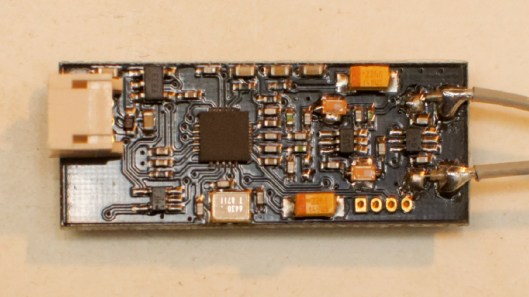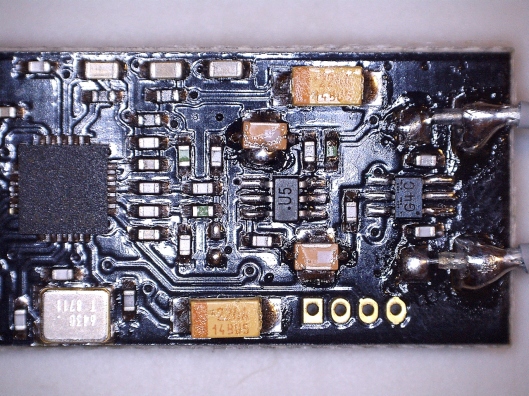Introduction
The KS-Servo SF800 is a third-party receiver for the Futaba S-FHSS protocol. I’m planning to use it in a mini-quad for my children to learn on, because
- It claims to be compatible with the Futaba T6K T-FHSS transmitter;
- It supports S-Bus;
- It is significantly less expensive than the Futaba R3006SB receiver.
Although not important for this particular project, it is also a lot smaller than any Futaba manufactured receiver, as shown by the comparison with my R3006SB below. This should allow me to build compact quads like the Shendrones Flaco.

Binding and Installation
Binding the SF800 receiver to a Futaba T6K transmitter is straightforward:
- Create your model in the T6K transmitter.
- In the MDL SEL menu, set RX to S-FHSS.
- Turn the receiver OFF and the transmitter ON.
- Hold the BIND button on the receiver (its the only button) DOWN while turning the receiver ON.
- The red LED should come on initially, followed by the green LED to indicate that it has bound successfully.
The default mode after binding is S-Bus.
The receiver bound first time to my 6K transmitter. The Receiver tab in the cleanflight configurator confirmed that all receiver channels are working correctly. Bravo!
I installed the receiver in a Liberty Ducted Quad that I built for my children to fly on. Fail-safe setup was exactly the same as as with the Futaba receiver, and the fail-safe works properly.
Flight Testing
I tested the receiver using my Futaba T6K transmitter in a racing environment with 3 other pilots in close proximity and a course extending up to 100m from the transmitter with no problems. With no other transmitters nearby and unobstructed line of sight to the receiver I took it out to over 450m (1500′) away with no glitches or fail-safes.
Internals
Skip this section if you’re not interested in technical details!
I couldn’t resist removing the heatshrink from one of my receivers, to see what it’s made of and how it compares to the Futaba R3006SB architecture.

The first thing that is apparent (other than that I could do with a decent macro lens) is that the antennas are direct soldered to the PCB, rather than connected using a U.FL/IPEX connector as in the R3006SB, so they aren’t intended to be replaceable by the user. The build quality also seems significantly poorer than on the R3006SB.

Here’s a closer view of the RF front end, taken with the microscope. The IC on the far right by the antennas labelled “G4C” which identifies it as a CEL µPD2179TB SPDT RF switch that is used to switch between antennas for diversity. The output of the switch is fed via a filter to the IC in the middle labelled “U5”, a UA2725 Low Noise Amplifier (LNA) with a gain of 20 dB and noise figure of 1.9 dB at 2.4 GHz. The output of the LNA goes to the IC on the far left, a TI CC2500 like the one used in the R3006SB (the marking has been scratched off, but not sufficiently to obscure it completely – I guess even the cloners don’t want their boards cloned). The differential inputs of the CC2500 are properly matched using the +90°/-90° phase shift network found in the device’s datasheet.
Overall, the receive path is very similar to that of the R3006SB, so I expect the sensitivity (and hence range) to be similar. Of course, since S-FHSS does not support telemetry, the SF800 does not require a transmit path. This simplifies the circuitry significantly, removing an RF power amplifier and a couple of RF switches. This, along with the replacement of the large Futaba connector with a smaller connector supporting only single SBUS/CPPM channel accounts for the size reduction.

Pingback: Liberty Ducted Quad | RF Eng FPV
Pingback: Thoughts on the Futaba 6K for Miniquads | RF Eng FPV
Do you know if it is possible to get the rssi signal in a channel 8 for instance?
LikeLike
Hi Raul
Unfortunately I don’t believe it has an RSSI output.
LikeLike